Featured Comment:
“I love cooking Japanese food and found myself with too much kabocha on hand, so I just had to try this. I was hesitant about the amount of sugar, but the loaf turned out just sweet enough and perfectly complemented the spices!”
– Dee Mal
What is Kabocha Loaf Cake?
Kabocha loaf is a delicious cake flavored with pureed kabocha and spices, baked in a rectangular loaf pan. Kabocha (かぼちゃ), also commonly known as “Japanese pumpkin,” is a type of winter squash with dark green edible skin and sweet, smooth orange flesh. Its flavor is sometimes compared to butternut squash, but the deep sweetness is more like a cross between a pumpkin and a sweet potato.
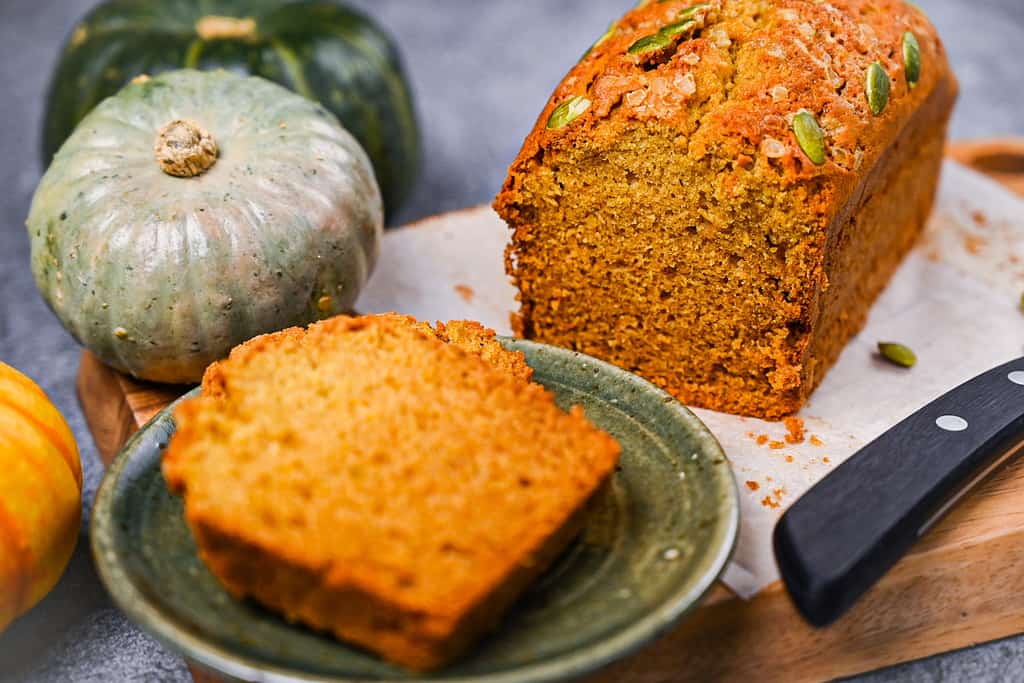
In Japan, kabocha is planted in the spring and harvested from late summer to early autumn. Once harvested, it can be stored for several months and is considered a valuable source of nutrition during the winter. There is even a Japanese custom of eating kabocha on the day of the winter solstice, which is believed to bring good health during the chilly winter months.
Thanks to kabocha’s naturally sweet and complex flavor, it is a versatile ingredient commonly used in both sweet and savory dishes.
In this recipe, I will show you how to fully utilize Japanese kabocha to make a deliciously comforting kabocha loaf cake flavored with a variety of spices!
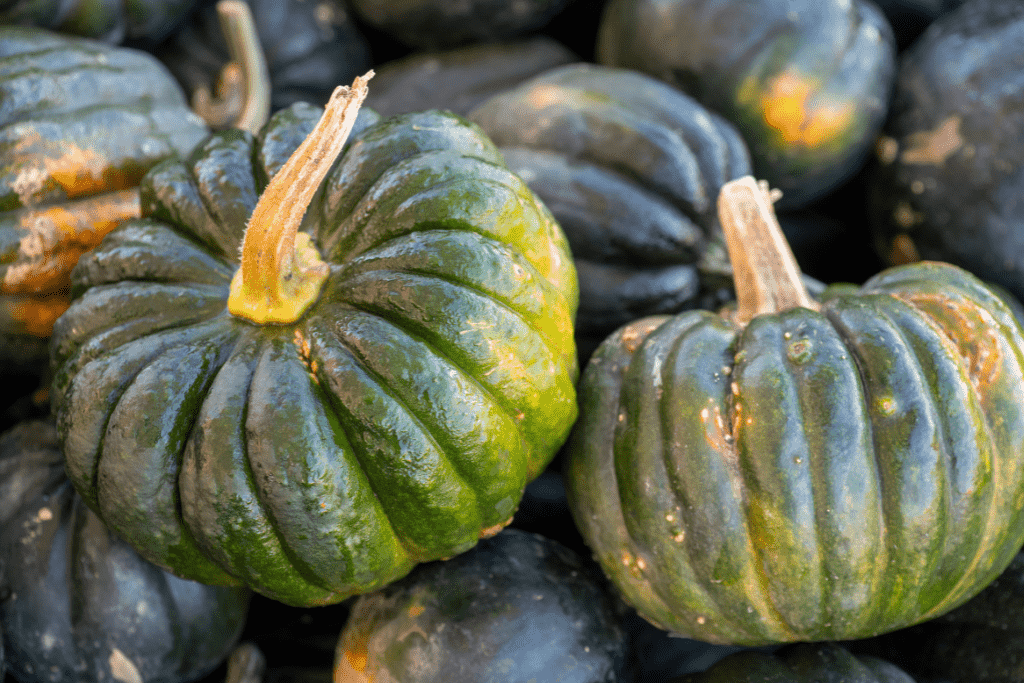

How I Developed This Recipe
This Spiced Kabocha Loaf Cake recipe was inspired by pumpkin bread. However, since regular pumpkins are not so easy to find in Japan, I decided to try to create my own pumpkin loaf using kabocha, an ingredient that is readily available to me.
I must say that the natural sweetness of kabocha really shines through in this loaf, and the addition of warming spices gives it a comforting feeling that makes it perfect for autumn. I also love to sprinkle some coarse sugar and pumpkin seeds to the top to give a bonus crunchy texture.
I make this Kabocha Loaf Cake every fall and enjoy it toasted with a thin layer of butter and honey. It makes the perfect snack, afternoon tea cake or even breakfast treat!
Ingredients & Substitution Ideas
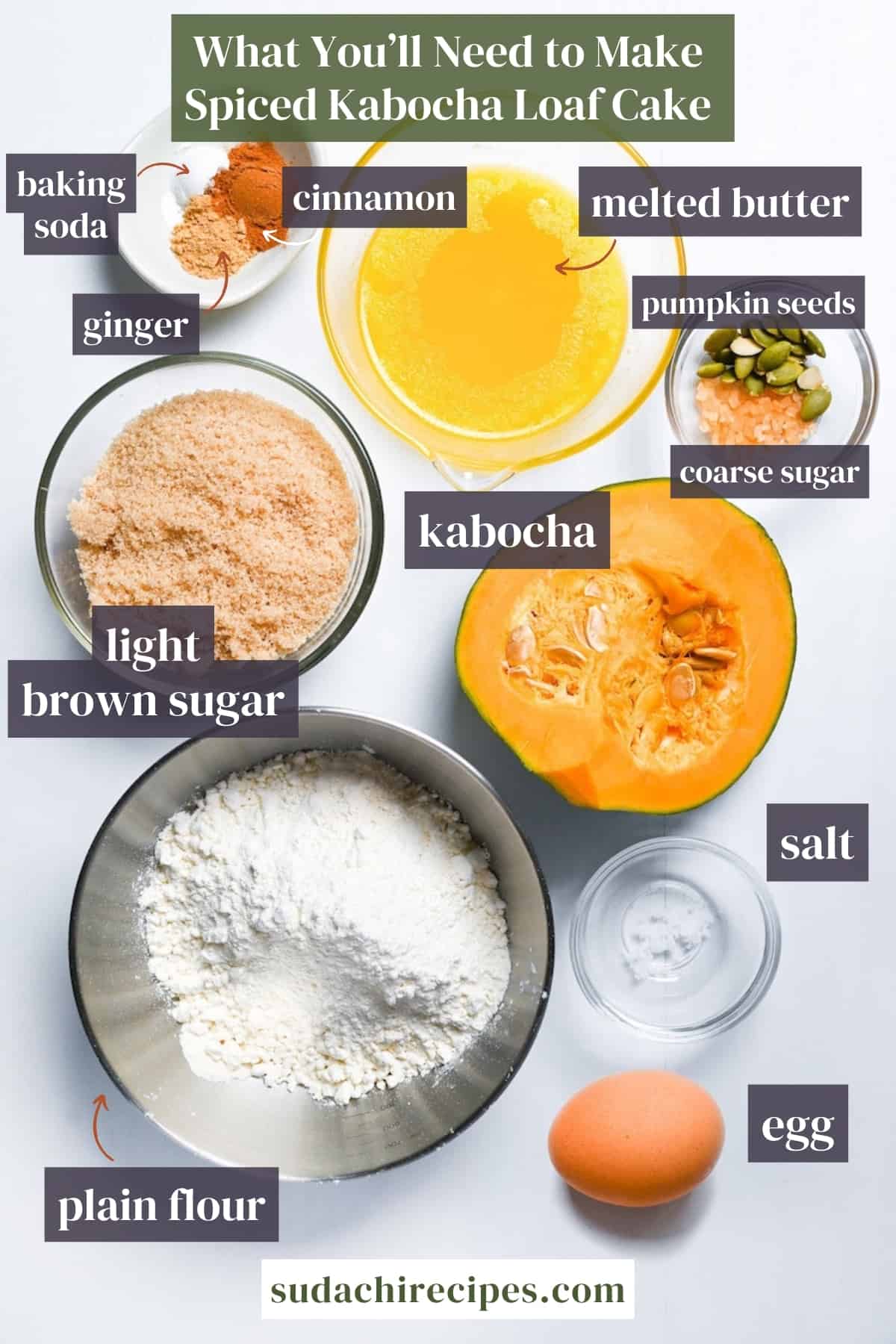
To make kabocha loaf cake, you will need the following ingredients:
- Kabocha: The smooth texture and sweet taste of kabocha makes it the star of this dish! However, this recipe also works with pumpkin puree if you can’t get hold of kabocha. If using pumpkin puree, I would use half a 15oz can (425g) per loaf.
- All-purpose flour: Although this loaf cake might be considered a type of “quick bread” (like pumpkin or banana bread), it is important not to use bread flour since it will make the texture too heavy. A light flour with less gluten works best, so I recommend all-purpose flour or cake flour.
- Baking soda: Reacts with the light brown sugar to help the loaf rise.
- Spices: Cinnamon and ginger powder add flavor and warmth to the loaf. Feel free to add other spices commonly associated with pumpkin such as nutmeg, allspice, or cloves (be sparing though, too many spices will overpower the kabocha!).
- Salt: a small amount of regular sea salt helps enhance the sweetness and flavors of the other ingredients.
- Light brown sugar: it is important to use light brown sugar in this recipe, not only for sweetness and a moist texture but also because the acidity in light brown sugar reacts with the baking soda creating the perfect rise and slightly cracked top.
- Egg: Plays an essential role in the structure and texture of the loaf.
- Melted butter: Adds moisture and a rich buttery flavor. I recommend unsalted to have more control over the salt content.
- Coarse sugar: I sprinkle the top of the loaf with turbinado sugar (known in Japanese as “zarame”) to create a crunchy texture.
- Green pumpkin seeds: sprinkle over the top before baking for decoration and extra crunch.
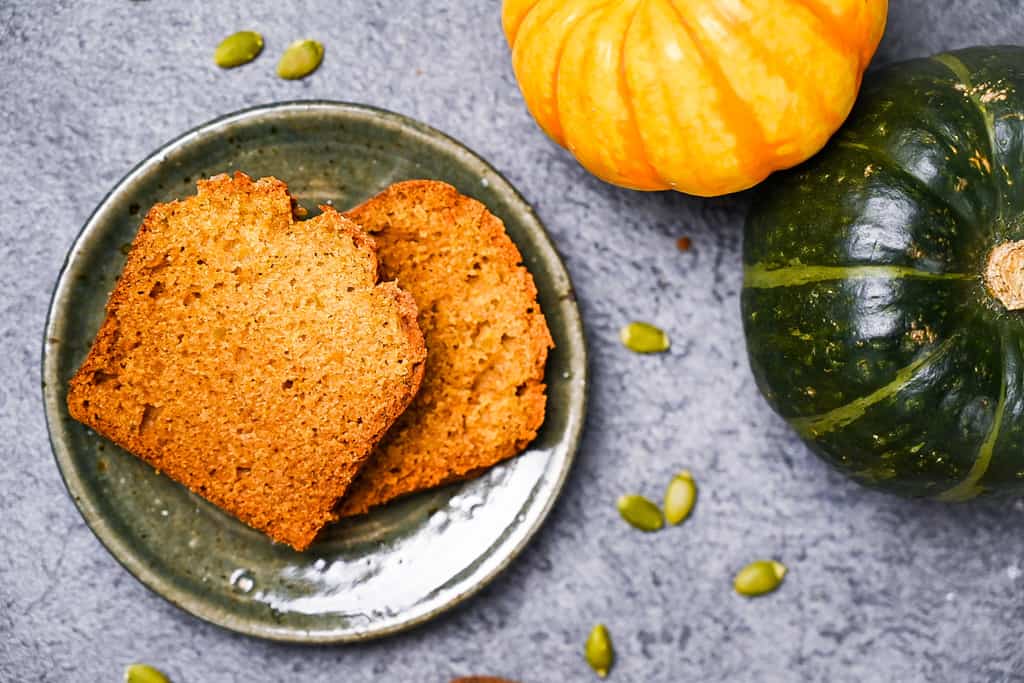
Visual Walkthrough & Tips
Here are my step-by-step instructions for how to make Spiced Kabocha Loaf at home. For ingredient quantities and simplified instructions, scroll down for the Printable Recipe Card below.
If you prefer to watch the process in action, check out my YouTube video of this recipe for a complete visual walkthrough!
How to make Kabocha Purée
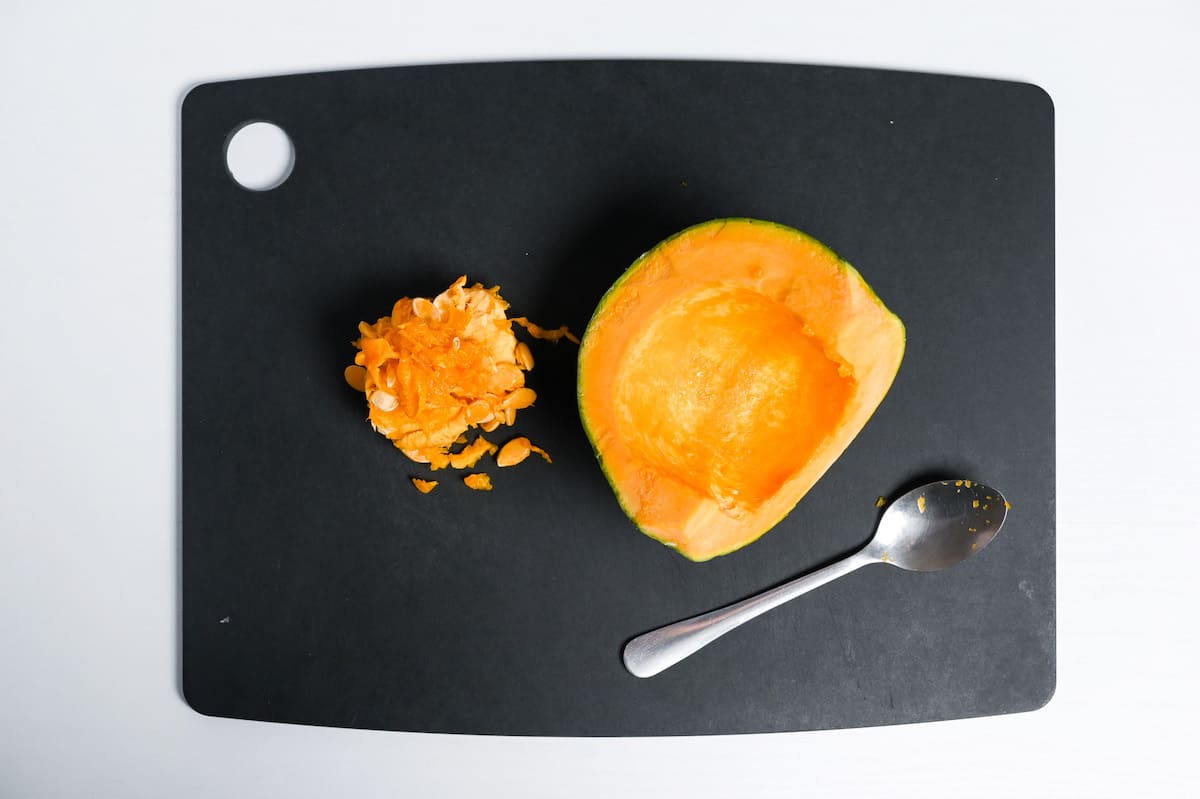
Cut the kabocha in half, then scoop out the pulp and seeds. You can roast the seeds and make them into a snack. Otherwise, discard them.
In this recipe, I recommend using between 170-240g of kabocha, which is about 350-400g before peeling and scooping out the pulp. This is equal to approximately one-quarter of a medium (regular-sized) kabocha.
Although the skin is edible, I prefer to peel it off for a smoother texture in the loaf. This is optional, but highly recommended. I use a heavy-duty potato peeler to remove the skin (please take extra caution if you use a regular knife).
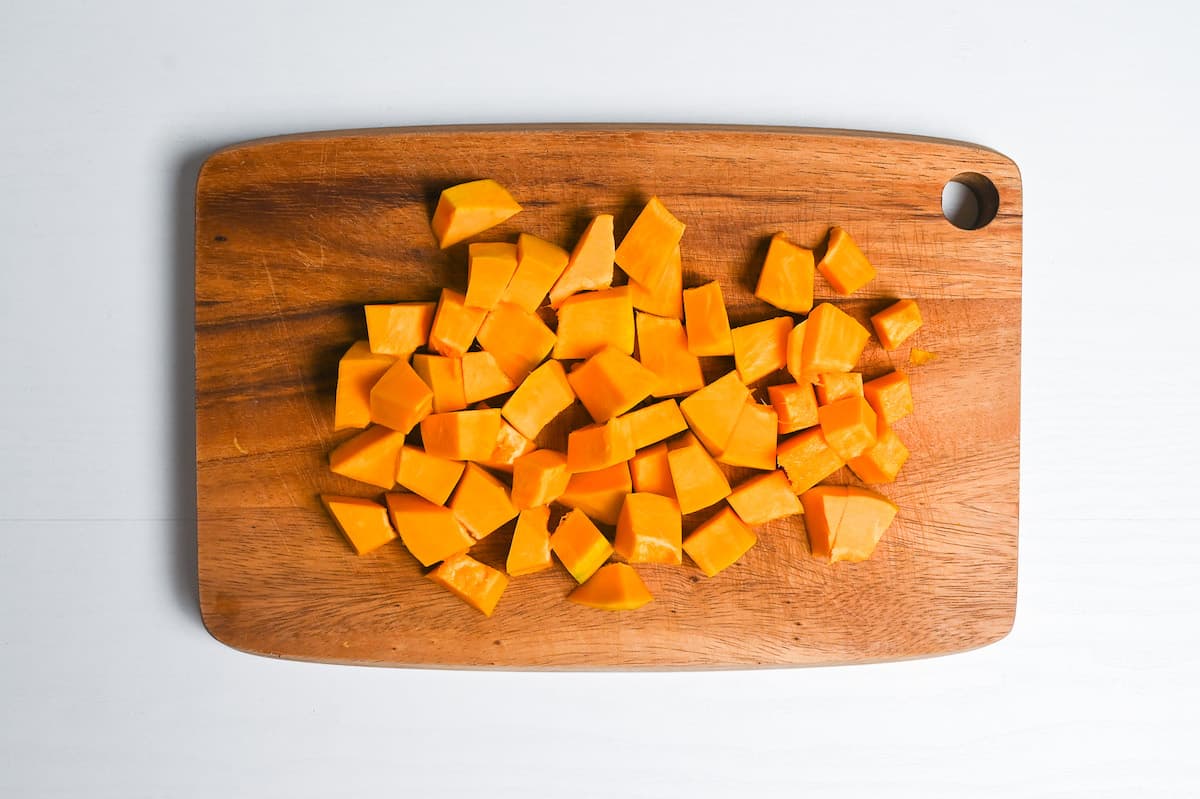
To speed up the cooking process, cut the kabocha into small cubes. Smaller cubes cook faster, and will be easier to mash later. Try and cut them so that they are uniform, this will ensure even cooking.
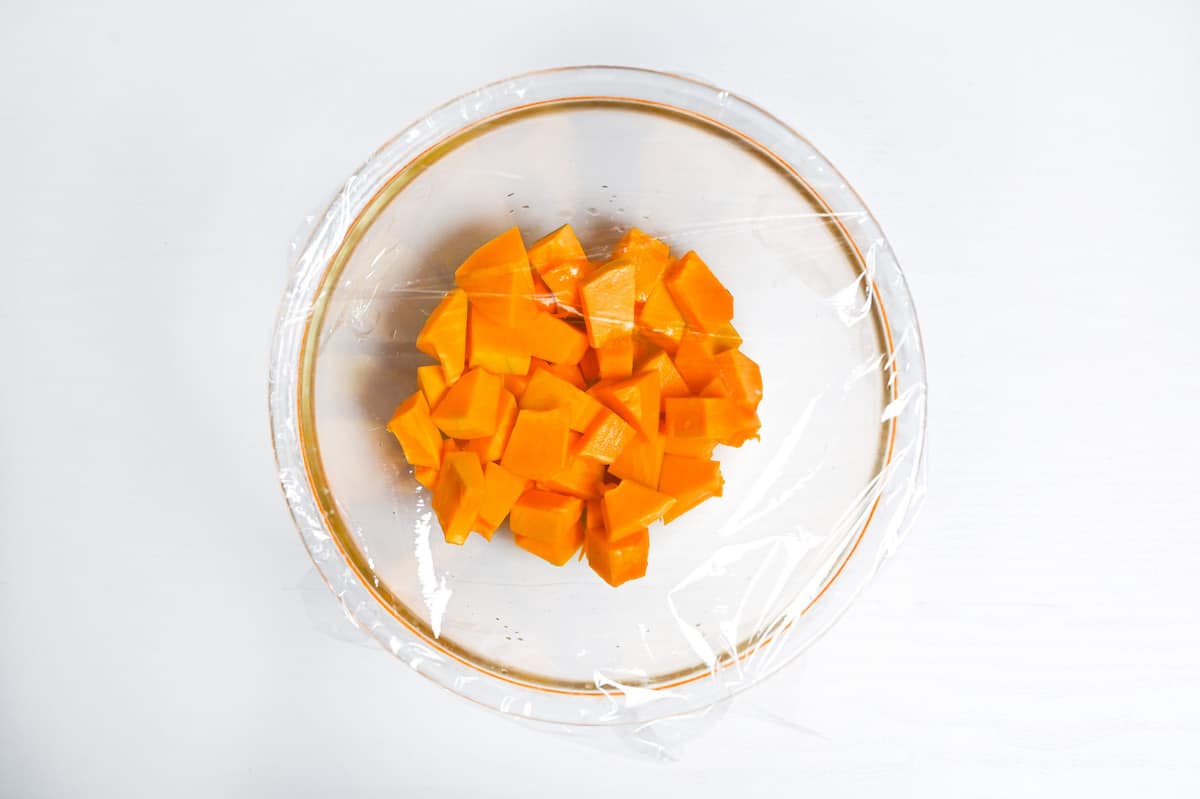
To mash the kabocha, we must first cook it. There are several ways to do this (boiling, steaming, baking) but I find the most efficient method is to microwave them. Simply place the kabocha in a heatproof bowl with a splash of water, cover with plastic wrap, and microwave for 4 minutes at 600W.
The kabocha should be soft enough to pierce easily with a fork.
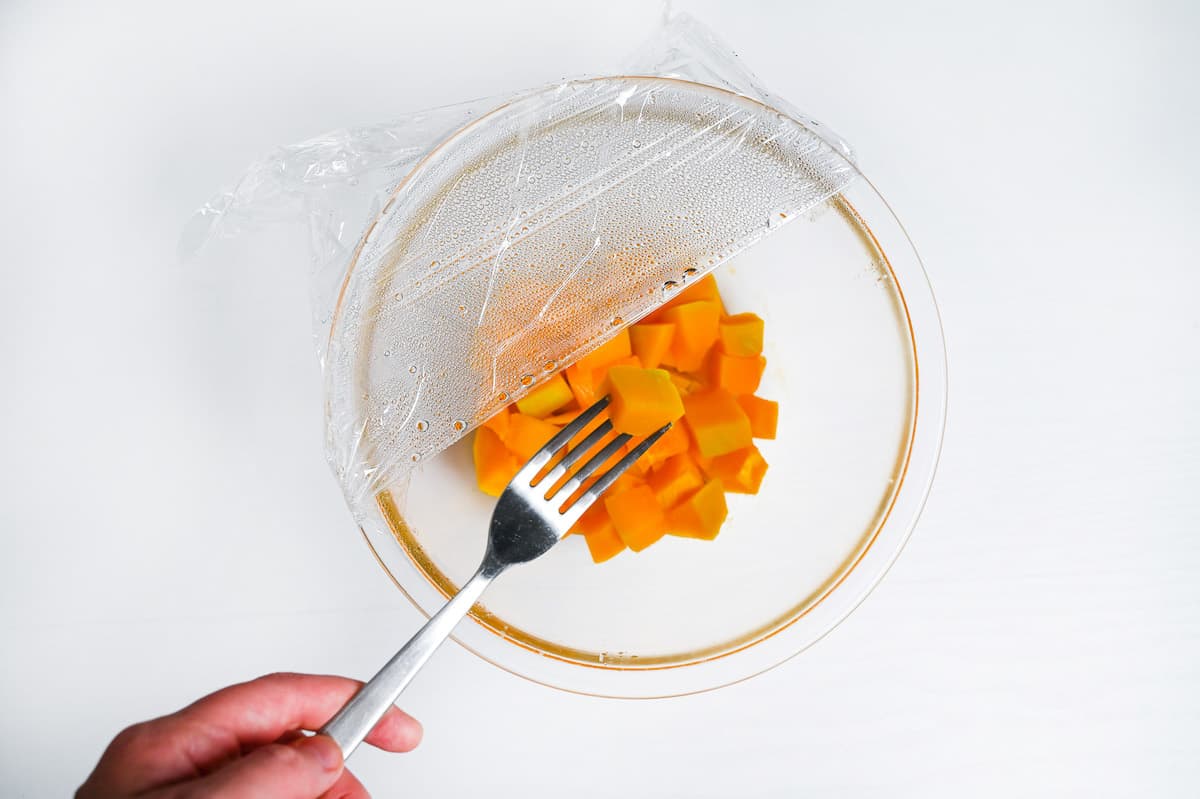
Slowly peel back the plastic wrap, being careful of released steam. Pierce with a fork to test the softness. If the kabocha is still hard, cover once more and continue to heat in 20 to 30-second intervals until fork tender.
Using more kabocha will increase the microwaving time. If you double or triple the recipe, microwave for 2-3 minutes at a time and mix each time to ensure the kabocha is evenly cooked.
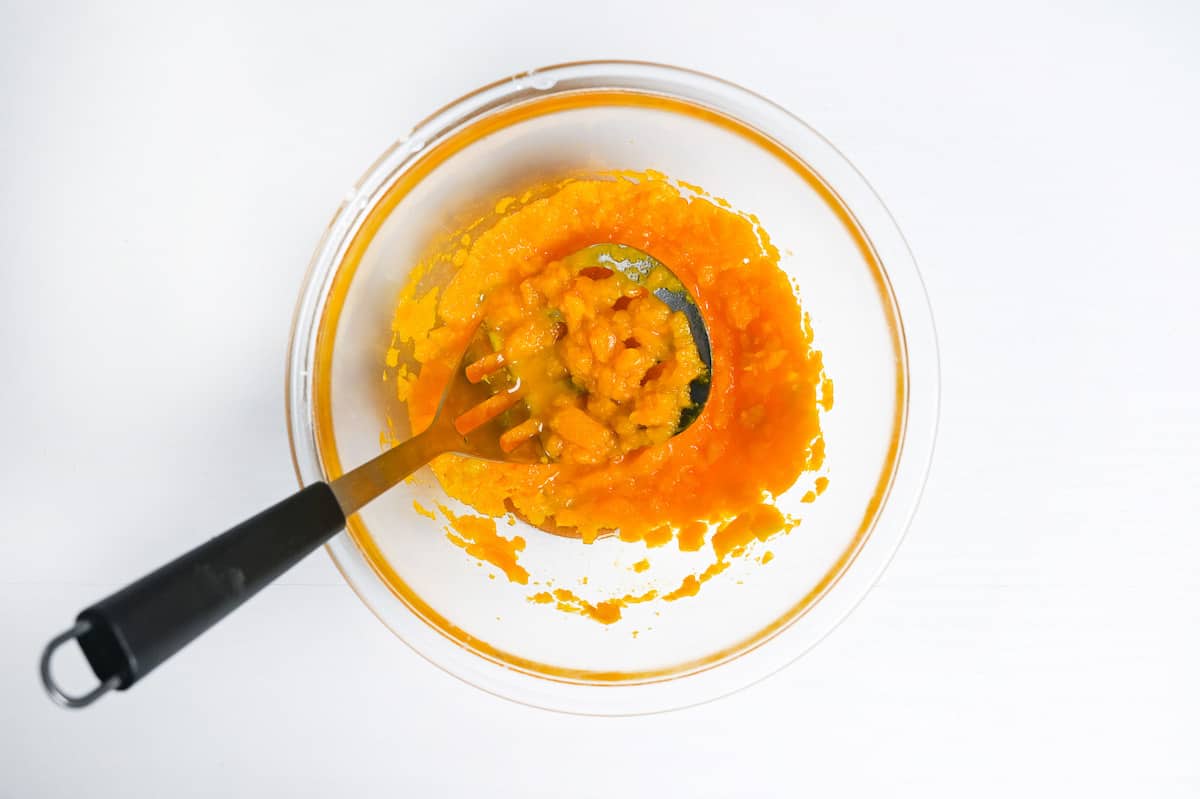
Mash with a potato masher until smooth.
Note: The texture of the kabocha puree should be quite loose and a little watery – loose enough to mix with a whisk. The cooking method used to cook the kabocha may affect the texture of the puree (for example, oven-roasted might be drier and thicker). If you feel it’s too thick and not workable, try adding a small amount of water.
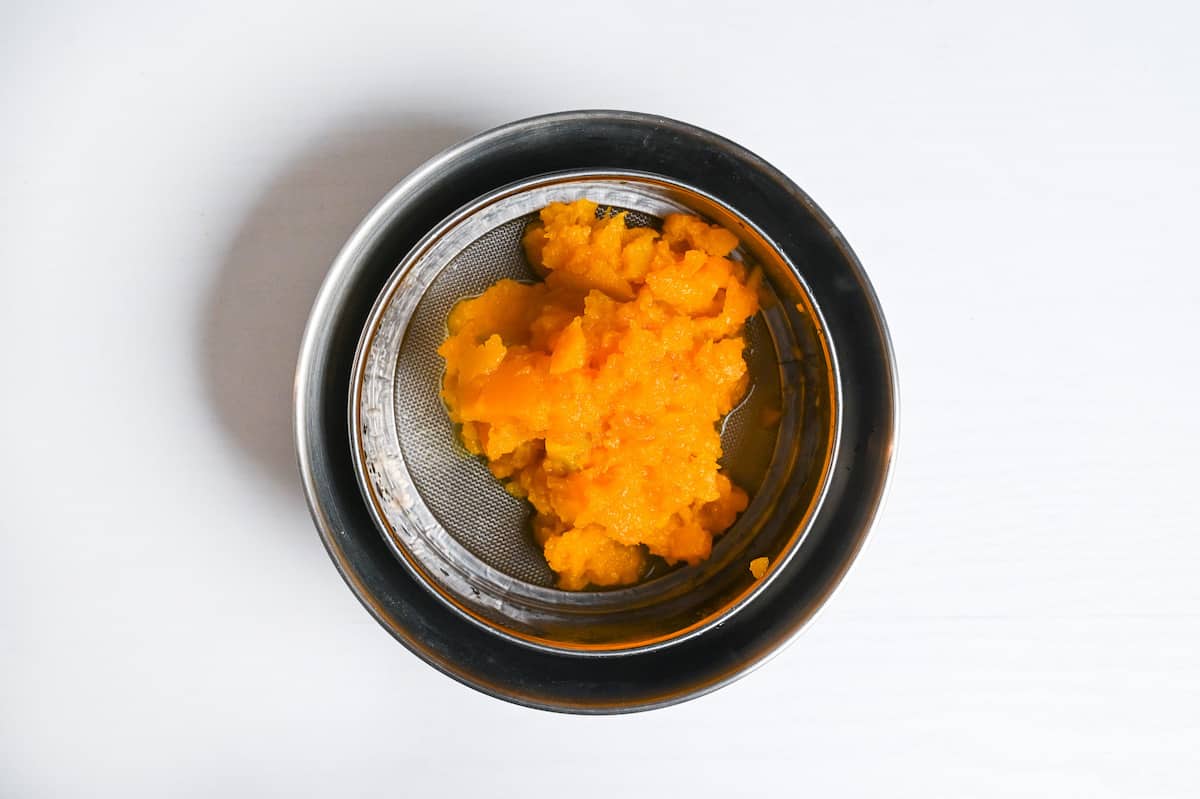
Optional: If you want to ensure the kabocha purée is perfectly smooth and combines seamlessly with the batter, I recommend taking one extra step to smooth it. I used a fine mesh sieve and worked the kabocha through by scraping it with a spatula. An immersion blender or food processor is ideal if you’re looking for a quicker and less labor-intensive method.
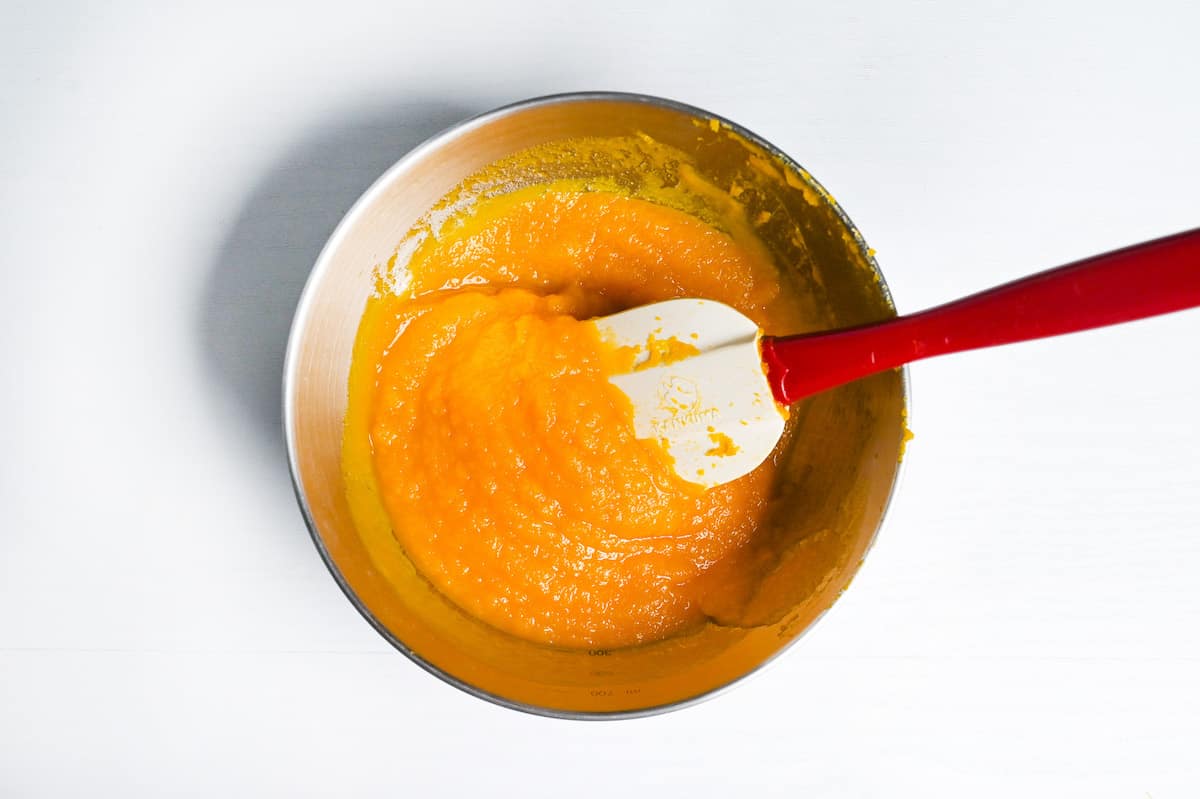
Once you’re happy with the consistency of your kabocha, cover it and leave it to cool. It should be cool enough to touch before adding it to the cake mixture.
How to Make Kabocha Loaf Cake
Make sure your kabocha purée is cool before you move on to the next part. Once you’re ready, preheat your oven to 170°C/338°F (160°C/320°F fan) and line a loaf pan with parchment paper.
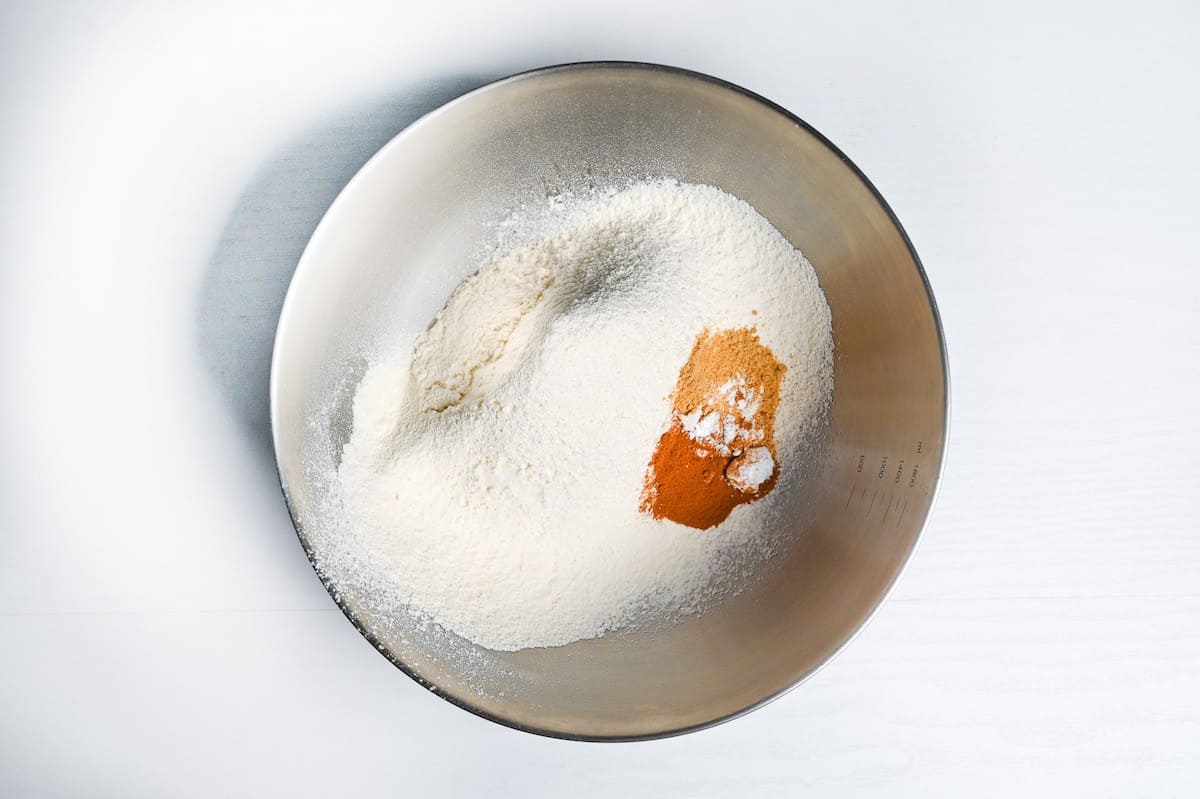
Sift the flour into a bowl and add the baking soda, cinnamon, ground ginger, and pinch of salt. Mix until evenly distributed and set aside.
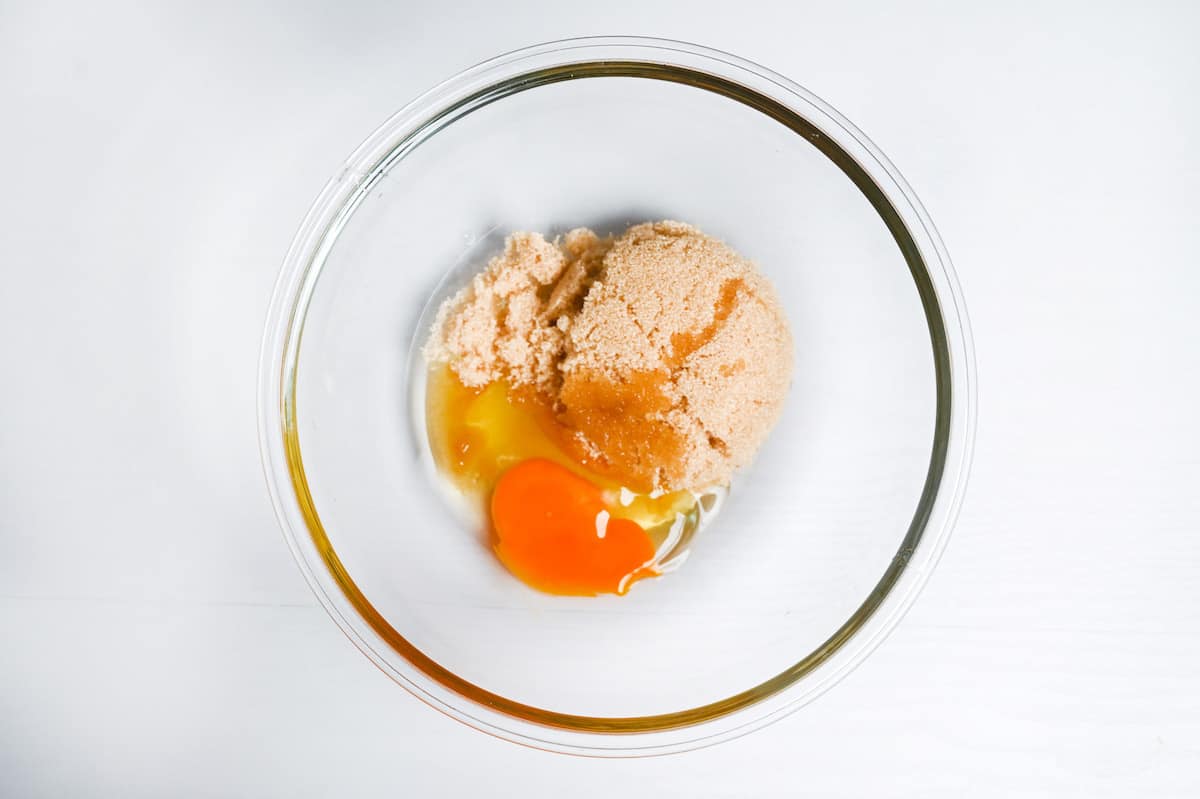
In a separate bowl, add the light brown sugar and egg, then whisk together until pale and smooth.
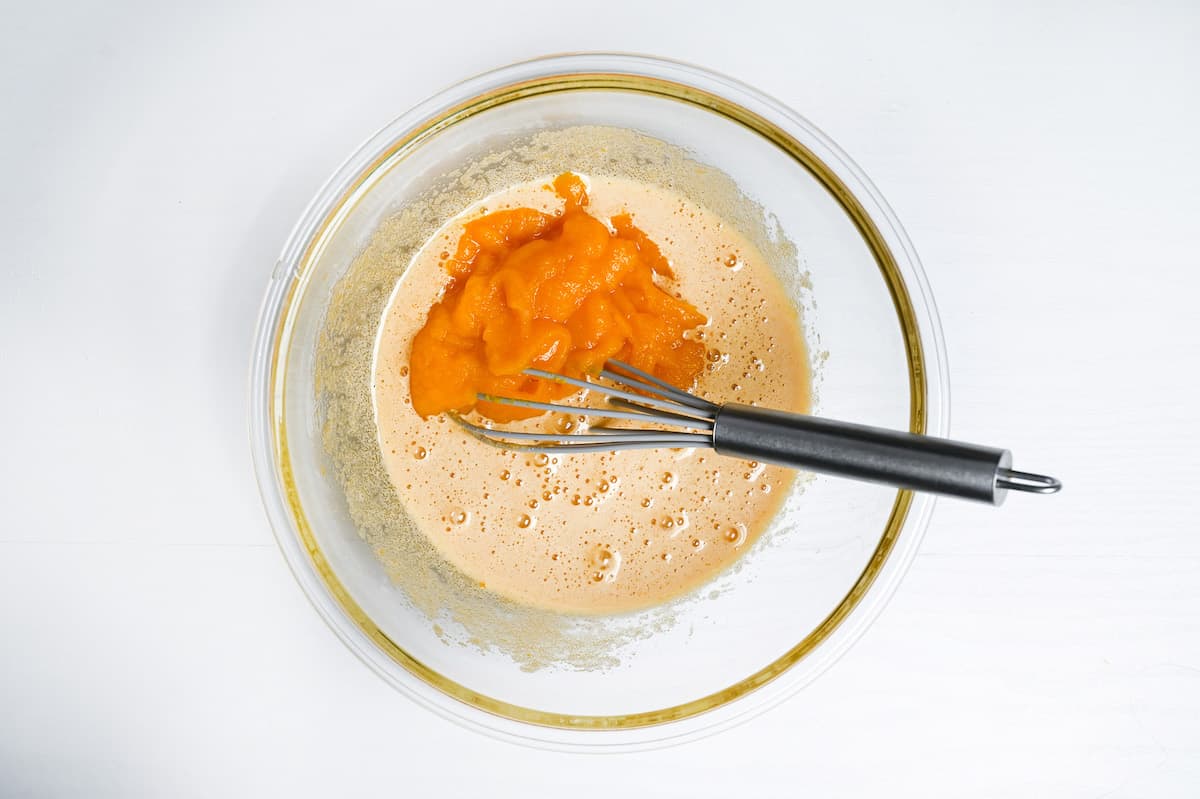
Then add the kabocha purée from earlier and whisk until evenly distributed.
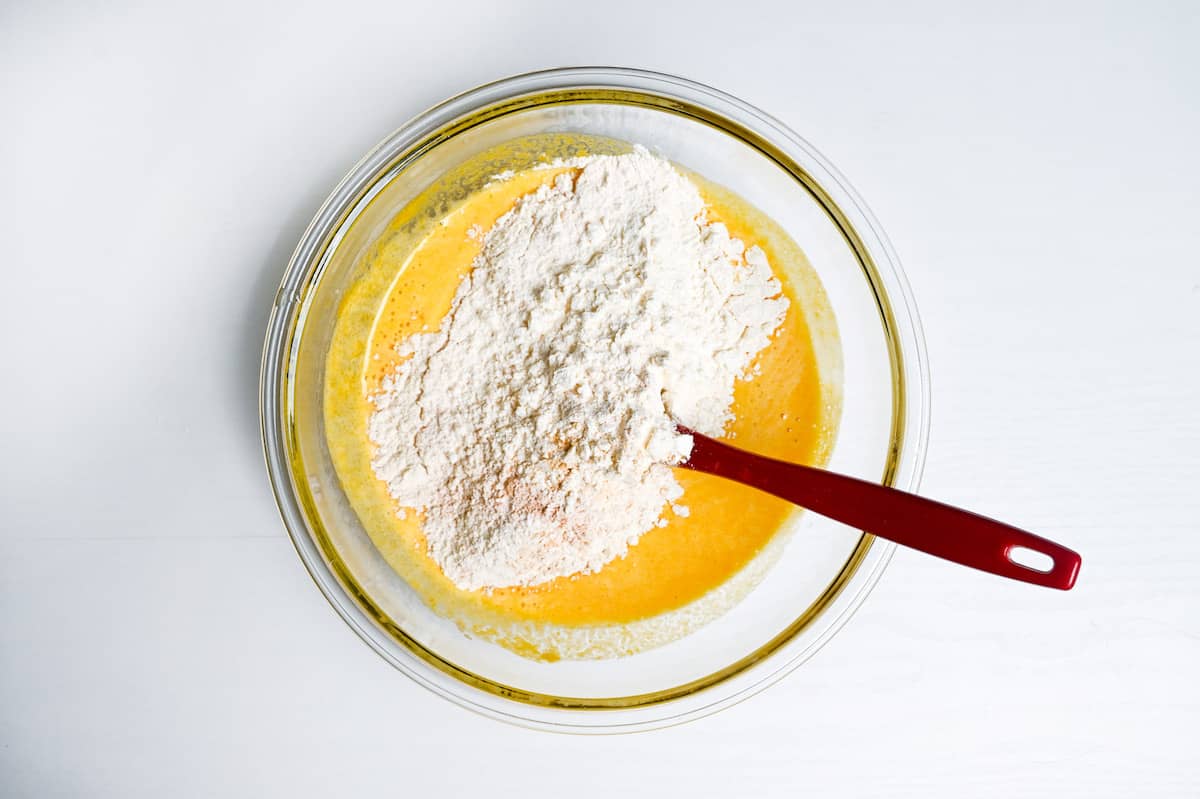
Pour the dry ingredients into the wet ingredients, and fold them together using a spatula or spoon. Be careful not to mix too vigorously or for too long; overmixing could make the final texture dense and chewy.
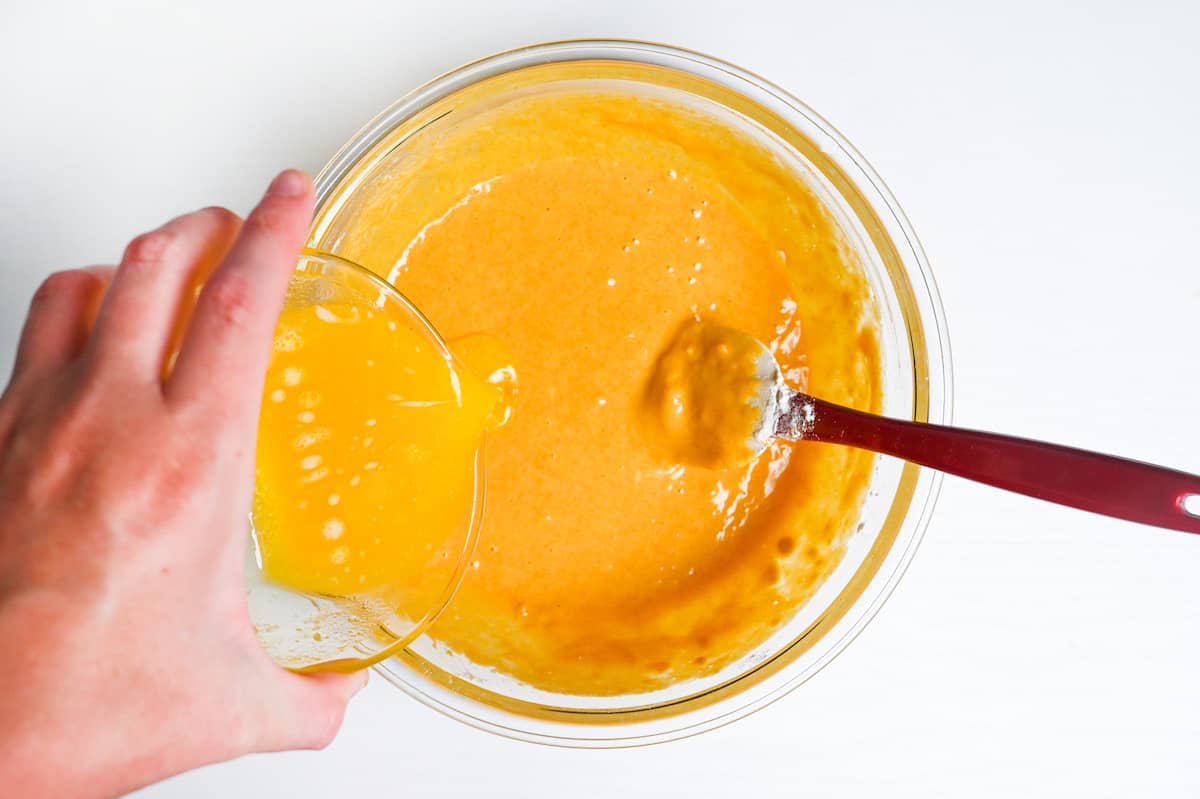
Pour the melted butter into the batter and continue to fold until fully incorporated.
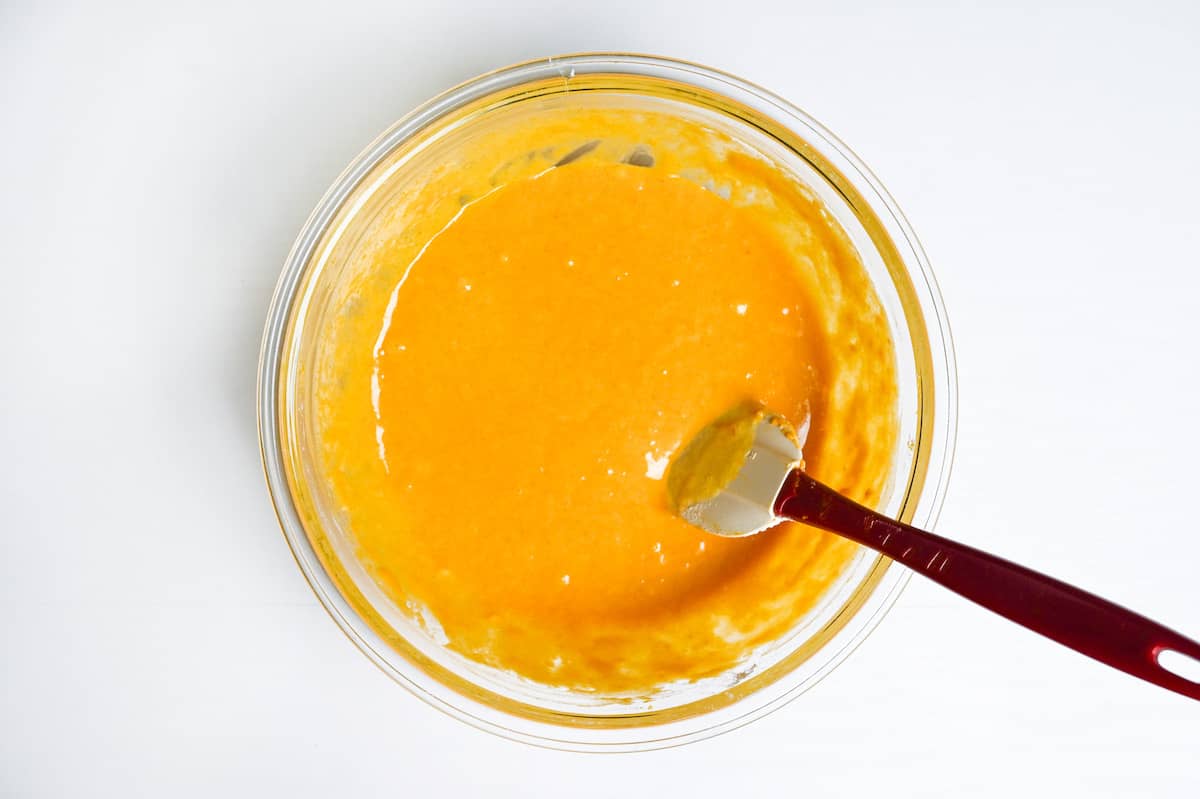
The final batter should look something like pictured above.
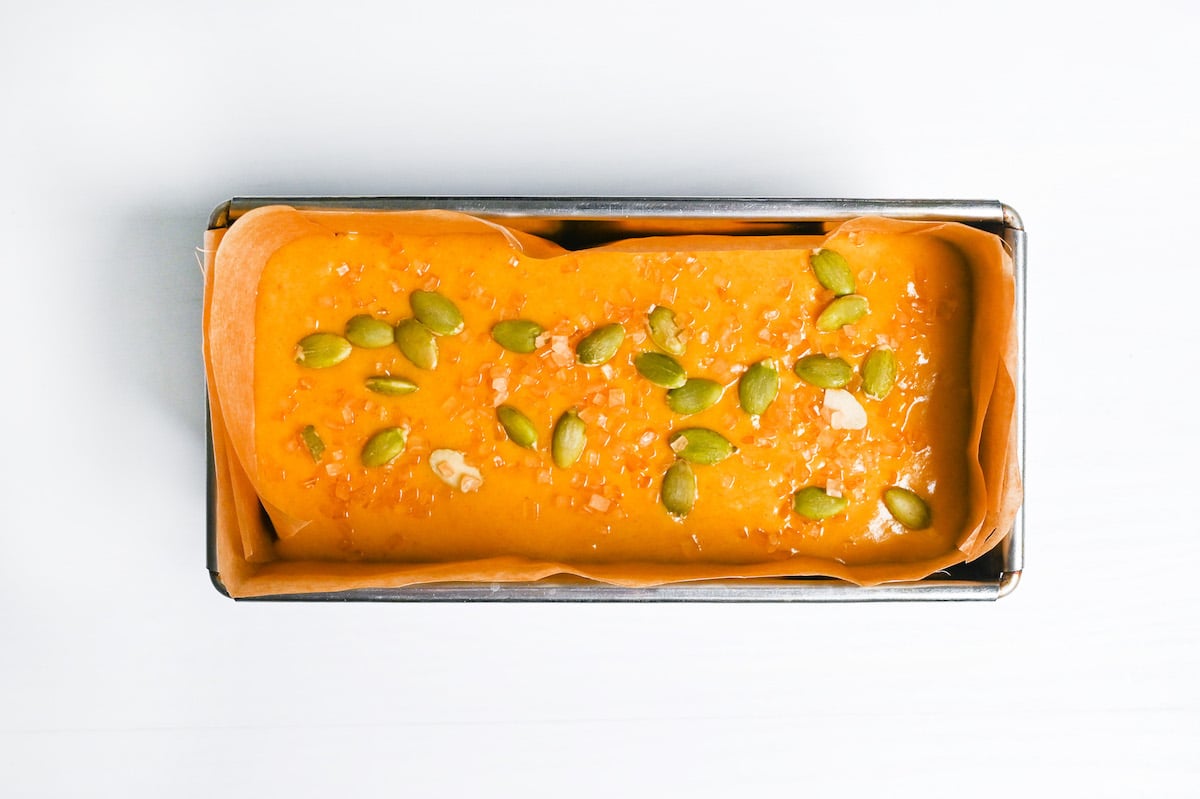
Pour the batter into the lined loaf pan and sprinkle the top with coarse sugar (I used turbinado) and green pumpkin seeds. The toppings are optional, but they add a wonderful crunchy texture to the top that I can’t live without!
Bake for 45 minutes or until a toothpick comes out clean with a few moist crumbs.
Note: Increasing the recipe/using a larger loaf pan will require longer cooking. Test with a toothpick after 45 minutes and check every 5 minutes. Cover the top with foil if it’s starting to burn.
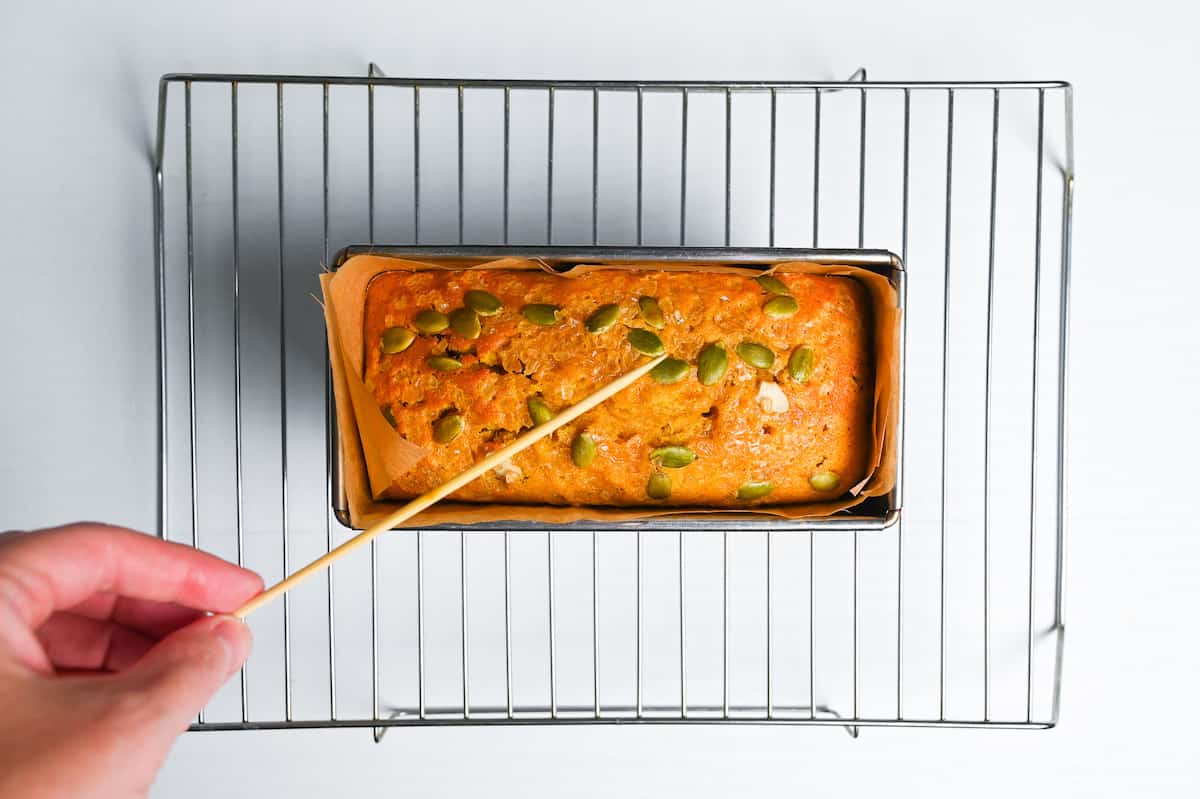
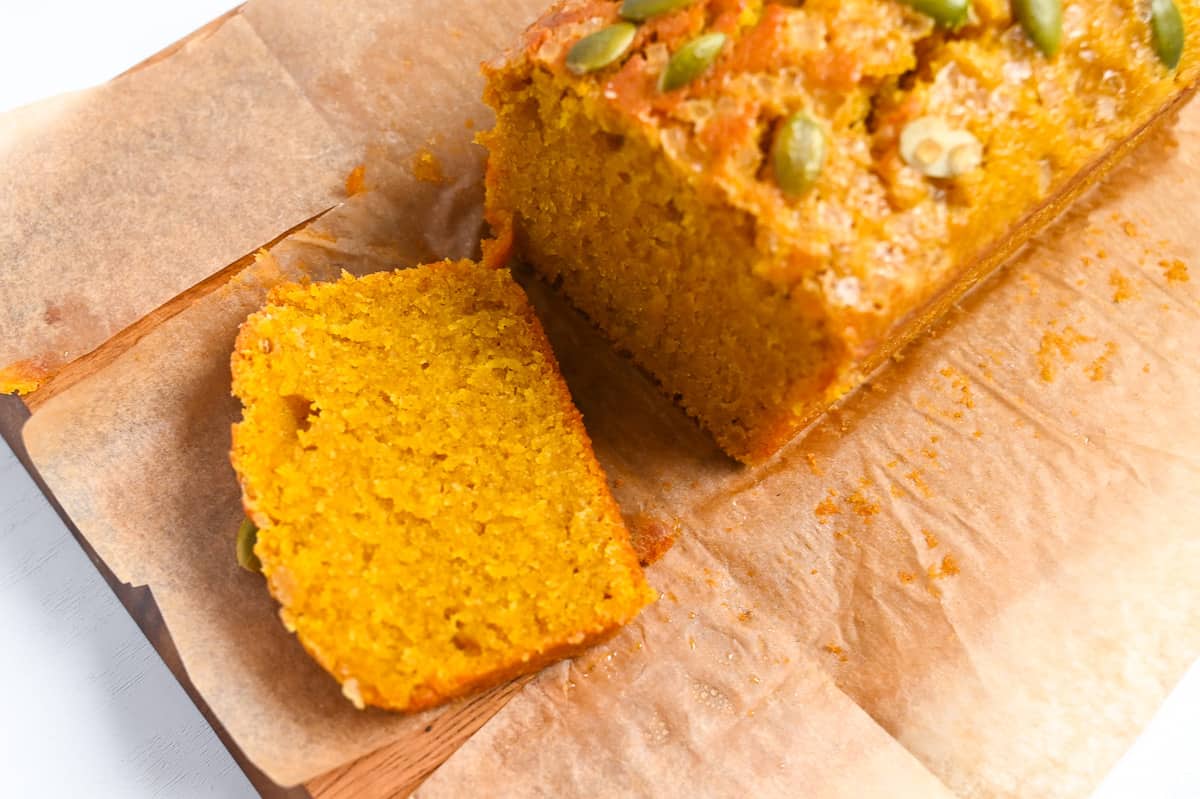
Leave to cool slightly before removing it from the pan, then transfer it to a wire rack to cool completely before storing.
Feel free to cut a slice while it’s still warm, and enjoy!
Tips and Tricks
Kabocha loaf cake is easy to make, but I have a few tips and tricks to ensure it is perfect every time!
- Remove the kabocha skin – this might be more down to personal preference, but I find the skin adds a strange texture to the cake.
- Use a sharp knife to cut – kabocha is very firm so make sure your knife is properly sharpened. You’re more likely to get injured with a blunt knife.
- Cut into small cubes – they cook faster and this saves time.
- Adjust the kabocha flavor to your taste – this recipe is pretty forgiving and the amount of kabocha doesn’t need to be exact. You can add more or less depending on how strong you want the kabocha taste to be. For each loaf, I recommend between 170-240g after peeling/scooping. Be aware that adding more pumpkin will add more moisture to the batter and it might take longer to bake.
- Add toppings – although this is optional, it really improves the texture of the loaf! The crunchy top is one of my favorite things about this recipe.
- Don’t overbake – overbaking will cause the loaf to be dry. When it’s nearly done, check with a toothpick or bamboo skewer regularly. It shouldn’t have any wet batter on it, but it also shouldn’t come out completely clean. A few moist crumbs means it is perfectly cooked!
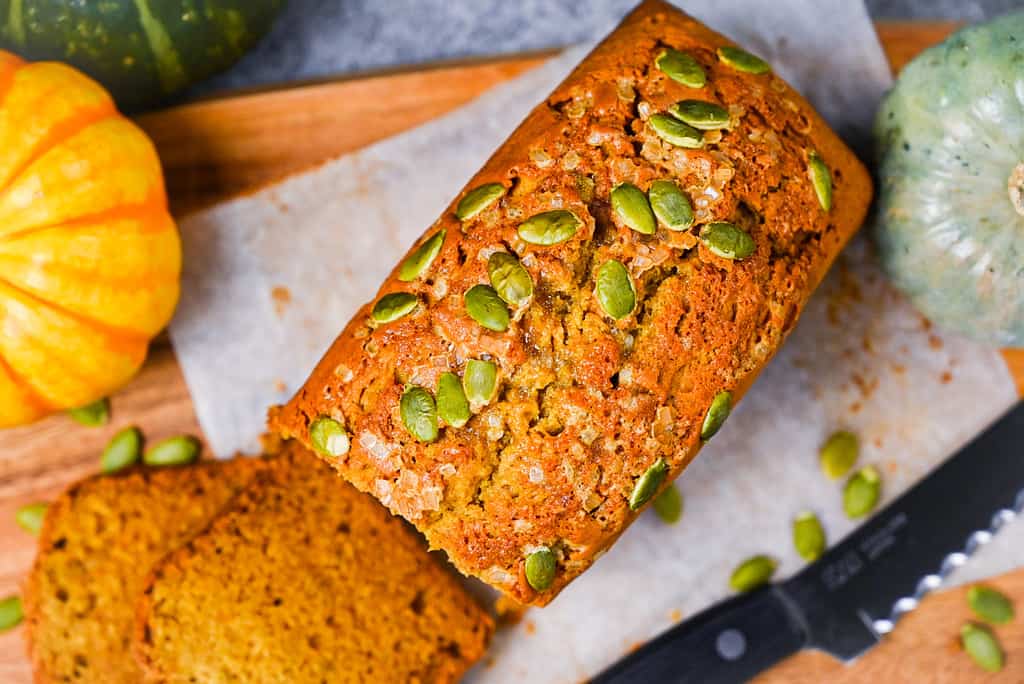
What Pan Size to Use
This recipe makes enough batter for one small loaf tin which is pretty standard in Japan. My loaf tin is 18x8x6cm (7x3x2.3inches), which fits about 2 cups (500ml) worth of loaf mixture.
The loaf rises a lot in the oven, so it’s actually enough batter even for pans larger than the one I used. If you are using a standard American loaf pan (9×5″) you might need to increase the recipe by x1.5 or double it.
Just be aware that the baking time might change depending on the size of your pan. (Deeper will take longer, wider will bake quicker.) Doubling the recipe will also increase the baking time to around 1 hour, possibly longer.
If increasing the recipe, I recommend using multiple pans rather than bigger pans. This way, you won’t need to adjust the baking time but you might need to rotate the pans to ensure even browning.
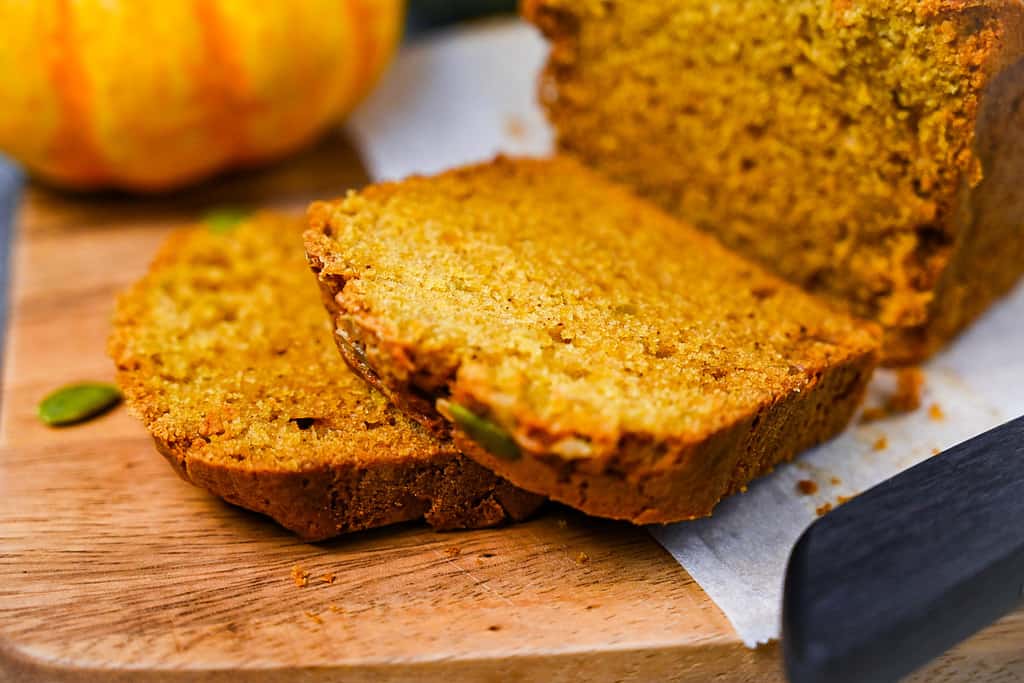
How to Store
I recommend eating a few warm slices straight from the oven to fully appreciate the freshly made kabocha pumpkin bread but if you don’t finish the loaf, you can store it in an airtight container. It will keep at room temperature for about 2 days (although, I don’t recommend this in summer as it tends to get very sticky), about 5 days in the fridge, and if properly stored, up to 2-3 months in the freezer.
Kabocha loaf can be thawed at room temperature or defrosted in the microwave. If the loaf has dried out, you can revive it by microwaving for 10-20 seconds. Toasting will give it that freshly baked feeling and I highly recommend it!
Storage summary
Room temperature – 2 days in an airtight container. (Not recommended in summer.)
Refrigerated – 5 days.
Frozen – 3 months.
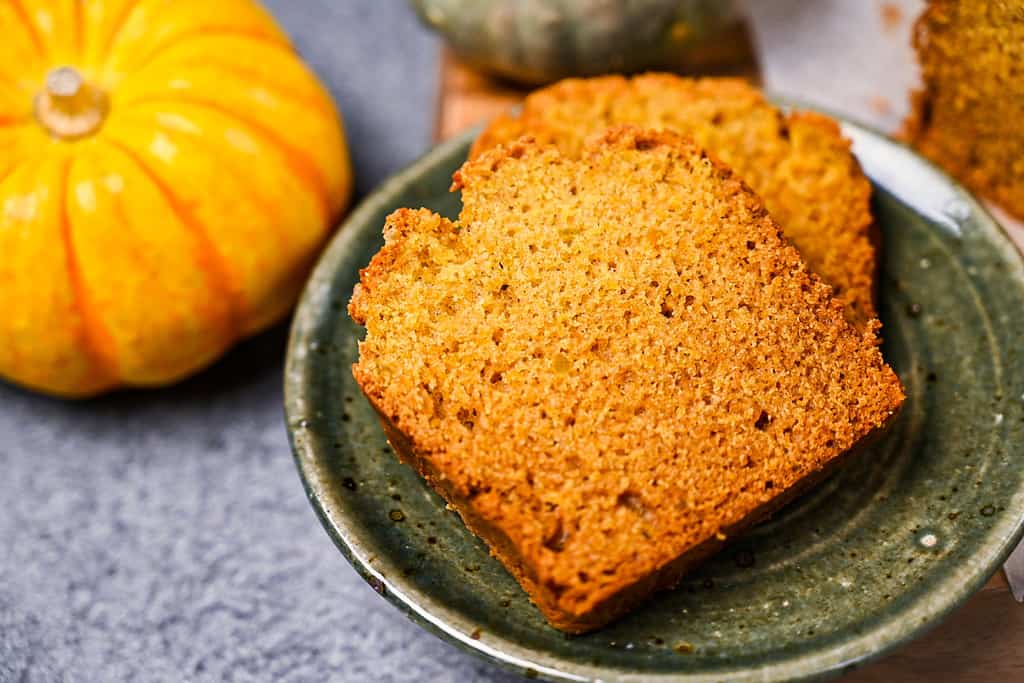
I hope you enjoy this Spiced Kabocha Loaf recipe! If you try it out, I’d really appreciate it if you could spare a moment to let me know what you thought by giving a review and star rating in the comments below. It’s also helpful to share any adjustments you made to the recipe with our other readers. Thank you!
More Kabocha Recipes
- Kabocha Korokke (pumpkin croquettes)
- Kabocha no Nimono (simmered kabocha)
- Tempura Batter (kabocha is perfect for tempura!)
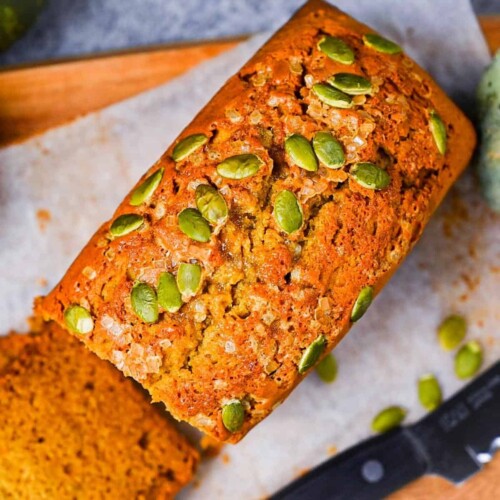
Spiced Kabocha Loaf Cake (Pumpkin Bread)
Equipment
- 7.3"x3.8" Loaf Pan or 9"x5" loaf pan
- Cooling rack
Ingredients
- 170-240 g kabocha squash (after peeling) OR canned pumpkin puree
- ½ tbsp water
- 140 g all-purpose flour
- ½ tsp baking soda
- ½ tsp cinnamon powder
- ½ tsp ginger powder
- 1 pinch salt
- 135 g light brown sugar
- 1 egg
- 70 g unsalted butter melted
- 1 tsp coarse sugar (turbinado/zarame or similar) optional
- green pumpkin seeds optional
My recommended brands of ingredients and seasonings can be found in my Japanese pantry guide.
Can’t find certain Japanese ingredients? See my substitution guide here.
Instructions
How to Make Kabocha Puree
- Cut 170-240 g kabocha squash into small pieces and place them in a microwavable bowl.

- Sprinkle with ½ tbsp water and cover the bowl with plastic wrap. Microwave the kabocha for 4 minutes at 600W. (If doubling or tripling the recipe, it will need longer.)

- Remove the bowl from the microwave and peel back the plastic wrap, be careful of the steam. Pierce a larger piece with a fork to check it's soft enough. If it's not, return to the microwave and heat at 20-30 seconds intervals until soft.

- Mash the kabocha with a potato masher until smooth.

- Optional step: make your kabocha puree extra smooth by either blitzing it in a food processor, immersion blender or worked through a fine mesh sieve.

- Leave to cool. (It should be cool to the touch before use.)

Making the Kabocha Loaf
- Preheat the oven to 170 °C (338 °F) (160 °C (320 °F) for fan-assisted) and line a loaf pan with baking paper.Sift 140 g all-purpose flour into a large bowl and add ½ tsp baking soda, ½ tsp cinnamon powder, ½ tsp ginger powder and 1 pinch salt. Mix well.

- Take a separate bowl and whisk 135 g light brown sugar and 1 egg until pale and smooth.

- Add the cooled kabocha to the egg and sugar mixture, and mix until evenly distributed.

- Fold the dry ingredients into the wet ingredients with a spatula and be careful not to overmix.

- Pour 70 g unsalted butter into the batter and mix until all the ingredients are well combined.

- Pour the batter into the loaf tin and sprinkle with 1 tsp coarse sugar and green pumpkin seeds (optional).Place in the oven on the middle shelf and bake for 45 minutes.

- Check the loaf with a toothpick, if it comes out clean it’s done. If it needs longer, put it back in the oven in 3-5 minute intervals and keep checking until the toothpick comes out clean. (A few moist crumbs means it’s done. If the toothpick has any wet batter it needs more time.)

- Allow to cool slightly before removing it from the loaf tin and transfering to a wire rack to cool completely.
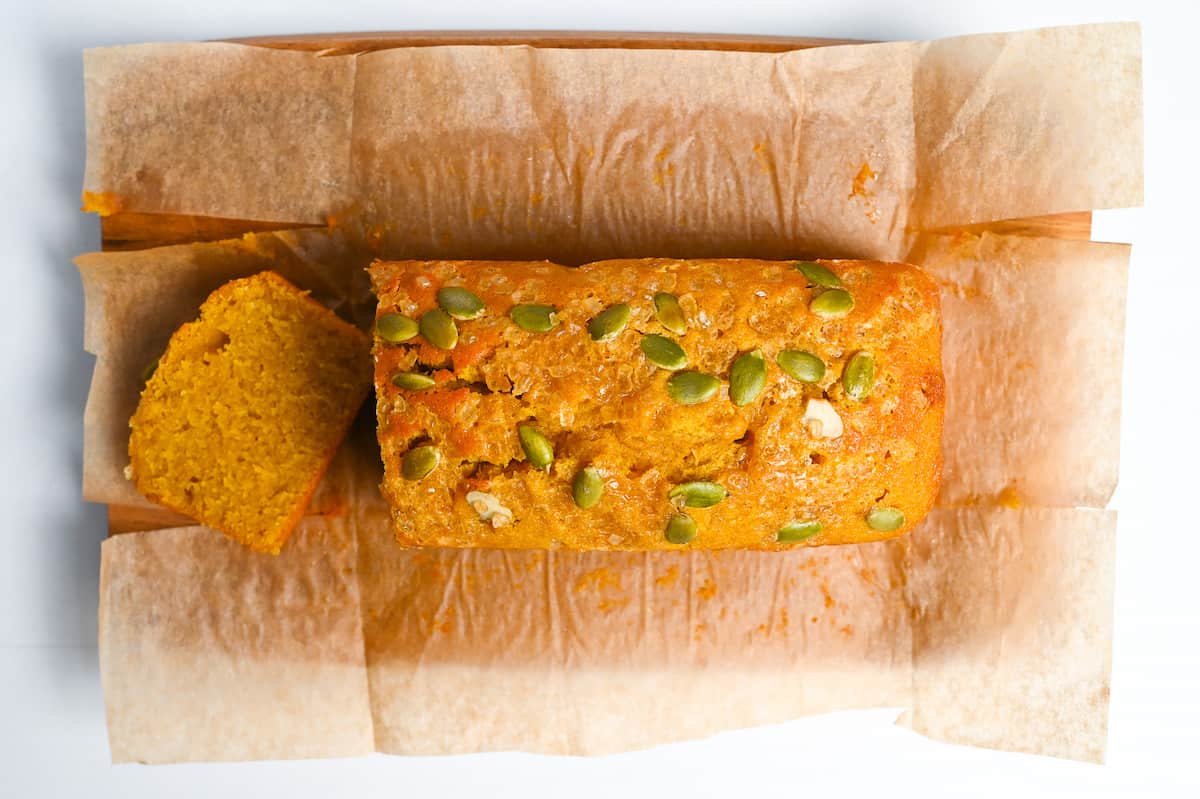
- Cut into slices and enjoy!

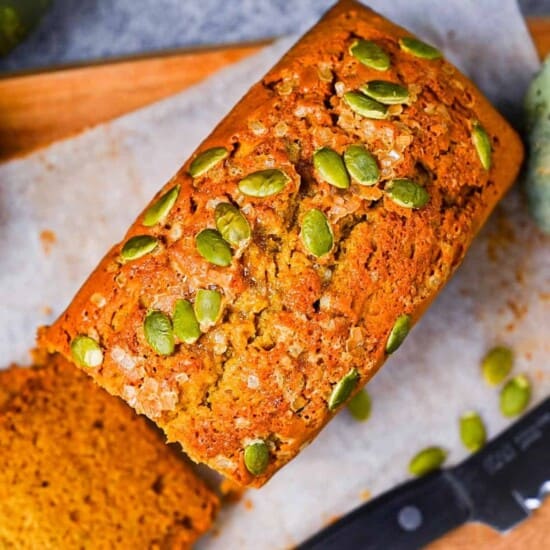



I love cooking Japanese food and found myself with too much kabocha on hand, so I just had to try this. I was hesitant about the amount of sugar, but the loaf turned out just sweet enough and perfectly complemented the spices!
Notes / Tips:
– I only had a 9×5 loaf pan (I believe the standard for Americans like me), and the recipe says to quadruple the ingredients for that pan size. The original ingredient quantity works just fine for this pan (though it did cook about 10 minutes longer, as expected). I actually don’t think I could have put more than 2-3 cups of batter, considering how much the loaf grew!
– since I quadrupled the recipe, I used the rest of the batter to make equally delicious muffins and got about 24 of them, in 2 standard-sized muffin pans. I upped the temp to 350F for the muffins and they were perfectly cooked at 20 minutes.
– To make it a bit healthier, I substituted half the butter with applesauce and it saved me a ton of calories, and still came out perfectly moist! My favorite health hack for baking 😉
– if you do quadruple the recipe, keep in mind that it’s a bit harder to soften the squash in the microwave and will need significantly more time!
So in total, I quadrupled the recipe and used about 2 cups of batter for the loaf (the normal recipe quantity) and the rest of the 3x batter for the muffins. Everything came out so delicious and I’ll definitely make this again!
Hi Dee,
Thank you for trying out my recipe, I’m so happy you enjoyed it!
Also thank you so much for the feedback, pans in Japan are usually smaller and when I follow American recipes I end up with too much batter, I did some research on the pan size and how to convert it, but I must have overcompensated this time! I’ll update the post, your comment has been very valuable!
I also love your idea of making muffins and using apple sauce, I’ll try that next time!
Hi Yuto,
Thanks so much for this wonderful recipe. I’ve made it twice now and it’s a great way to enjoy the seasonal kabocha up here in Hokkaido. I have had an issue with the batter though- every time I make it, the batter is incredibly thick. This leads to the bread being very gelatinous and gooey in the center. I think my kabocha purée ends up too thick from the start, because in your photos it looks much more liquidy. I was wondering if you have any suggestions. I usually boil the kabocha and remove the skin, using a Vitamix to blend with the egg and sugar mixture.
Thank you again!
Hi Lily,
Thank you so much for your kind words and trying the recipe!
Based on what you’ve said, it sounds like the way we cook the kabocha affects the texture of the kabocha purée. I think when I microwave the kabocha with water, the steam gathers at the top of the plastic wrap and then drips back into the kabocha making a looser purée when they’re mashed together. I recommend blitzing the kabocha in the Vitamix as you’re doing, but then add a little bit of water, blitz and repeat until you get a looser consistency.
Other than that, the cake should be moist but not overly gooey so another solution might be simply just baking it for longer and covering it with foil if it starts to burn.
I hope this has helped!
I will try out boiling the kabocha myself and update the post with my findings, thank you for your feedback!
All the best,
Yuto
Thanks so much for this recipe! I made this for my mum and I this weekend and it was amazing. I can’t believe how well it turned out!! Will be looking to try out more of your recipes soon and will definitely be making this again
Hi Robert,
Thank you so much for your comment and taking the time to let me know how it turned out! I’m so happy to hear that you and your mum enjoyed the recipe!
Yuto
I’m a Japanese American living in France since 2022. I grow my own kabocha every year because I haven’t been able to find it here. I used the standard American loaf pan with the standard recipe amount and that worked but it wasn’t the “normal” size that I’m used to. It was a very short loaf. It baked well enough and tastes incredible but, next time, I’m going to double the recipe for my standard American loaf pan. I have a double serving of pureed squash left in the freezer. I’ll wait for my husband’s family to be around and then I’ll make the double batch in a single American sized loaf pan and report back 🙂 I am sure it’ll need longer to cook but most of my other squash bread recipes take at least 55 minutes to cook at 350F so I imagine it’ll be a little longer than that since these cook at a slightly lower temperature. I added vanilla and ground cloves to my loaf and it’s now my favorite “veggie bread” recipe! I’m going to try replacing the kabocha with other veggies over the summer. I prefer the airier texture of this loaf recipe. I’m happy I stumbled onto it. Thanks for posting!
Hi Diane,
Thank you so much for your feedback, love your idea of adding cloves and vanilla!
Can I ask the dimensions of your pan? It looks a lot wider than my pan, but a previous commenter said they used a standard American pan (9×5″) and the original recipe was enough.
Despite your loaf being a bit short, the texture looks perfect and I’m happy you enjoyed the recipe!
Yuto